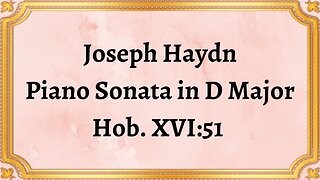Premium Only Content

Wolfgang Amadeus Mozart Clarinet Trio In E Flat Major, K 498
#WolfgangAmadeusMozart #ClarinetTrio #EFlatMajor #K498 #ClassicalMusic #ChamberMusic #ClassicalComposer #MusicalComposition #Clarinet #MozartianElegance
THE VIRTUOSO Sidney Fel, Wilfrid Parry;
The Wolfgang Amadeus Mozart Clarinet Trio in E Flat Major, K 498, also known as the "Kegelstatt Trio," is a remarkable musical composition that showcases Mozart's unparalleled ability to blend elegance, lyricism, and virtuosity. Composed in the late 18th century, this trio stands as a testament to Mozart's musical genius and his exploration of the clarinet as a prominent solo instrument.
Wolfgang Amadeus Mozart composed the Clarinet Trio in 1786, during a period of great artistic achievement. Mozart was a prominent figure of the Classical era, known for his prodigious talent and innovative compositions. The Clarinet Trio, written for clarinet, viola, and piano, showcases Mozart's fascination with the clarinet's unique timbre and his desire to explore new possibilities within chamber music.
The Clarinet Trio in E Flat Major, K 498 consists of three movements that highlight Mozart's exceptional craftsmanship and ability to create a harmonious interplay between the three instruments.
1. Andante: The opening movement begins with a lyrical and expressive theme introduced by the clarinet. The viola and piano join in, engaging in a delicate and intricate musical dialogue. Mozart's gift for crafting beautiful melodies and his mastery of counterpoint shine through in this movement, creating a serene and introspective atmosphere.
2. Menuetto: Allegretto: The second movement is a playful and lively minuet. Mozart infuses the movement with rhythmic buoyancy and charm. The clarinet, viola, and piano take turns presenting the melodic material, showcasing their unique voices and creating a delightful musical conversation. The movement is characterized by its elegant dance-like quality and Mozart's signature grace.
3. Rondo: Allegretto: The final movement is a spirited rondo that showcases Mozart's ability to combine virtuosity with melodic beauty. The clarinet takes on a more prominent role, displaying technical prowess and dexterity. The viola and piano provide a sturdy foundation, supporting the clarinet's melodic flights. Mozart expertly weaves together contrasting sections, creating a sense of excitement and resolution, leading to a brilliant and satisfying conclusion.
The Clarinet Trio has had a lasting impact on the world of chamber music. Mozart's exploration of the clarinet as a solo instrument within a chamber ensemble was groundbreaking for his time. The Clarinet Trio's sublime melodies, elegant interplay, and technical demands have made it a beloved and frequently performed work. Its influence can be seen in the compositions of subsequent generations, inspiring composers such as Johannes Brahms and Carl Maria von Weber to further explore the possibilities of the clarinet in chamber music.
Conclusion:
The Wolfgang Amadeus Mozart Clarinet Trio in E Flat Major, K 498 is a testament to Mozart's musical genius and his ability to create captivating and expressive chamber music. Through its elegant melodies, intricate interplay, and technical demands, this trio showcases Mozart's unmatched ability to blend elegance, lyricism, and virtuosity. The Clarinet Trio's enduring legacy serves as a reminder of Mozart's contribution to the world of classical music and his exploration of new possibilities within chamber music. Its enchanting melodies and harmonious interplay continue to captivate audiences, demonstrating the timeless beauty and brilliance of Mozart's compositions.
You have the opportunity to support the channel:
https://destream.net/live/RadSiarAl/donate
https://www.buymeacoffee.com/6355radsiaral
-
 6:07
6:07
Classical music_Music Inspiration
9 days agoJoseph Haydn Piano Sonata in D Major, Hob. XVI:51
401 -
 5:30:06
5:30:06
SpartakusLIVE
8 hours ago#1 King of Content kicks off YOUR week with Monday MOTIVATION
60.7K4 -
 5:56:52
5:56:52
Akademiks
6 hours agoKendrick Lamar Sweeps Grammys. Drake announces new album on Feb 14. Rocky Trial Might get Dismissed?
59.2K4 -
 3:25:02
3:25:02
BrancoFXDC
4 hours ago $1.47 earnedWarzone Rebirth Rounds
21.9K -
 1:44:14
1:44:14
Glenn Greenwald
11 hours agoRubio's Shift: What is Trump's Foreign Policy? Trump/Musk Attack CIA Fronts USAID & NED: With Mike Benz | SYSTEM UPDATE #401
84.7K74 -
 1:05:47
1:05:47
Donald Trump Jr.
12 hours agoMexico Sends Troops to Border, Plus USAid Scam Exposed, Live with Brooke Goldstein & Rep Brian Mast | TRIGGERED Ep.213
233K223 -
 9:26
9:26
Rethinking the Dollar
8 hours agoUnbelievable Government Waste: 5 Outrageous Biden-Era Spending Sprees
64.9K15 -
 2:37:43
2:37:43
Flyover Conservatives
1 day agoDR. KIRK ELLIOTT | Deep Dive: Tariffs, Tech, and Total Economic Warfare – Who Wins and Who Loses? | In Studio - FOC Show
61.4K4 -
 3:12:37
3:12:37
Danny Polishchuk
10 hours agoTariffs and Trade Wars + Nick Rochefort | Low Value Mail #136
44.5K3 -
 2:04:40
2:04:40
I_Came_With_Fire_Podcast
12 hours agoCartels vs The United States, Fentanyls 2 Front WAR, and FTOs
23.9K